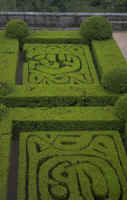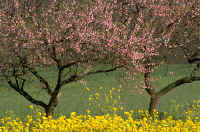|
|
|
|||||
|
|
||||||
|
||||||||||
|
Fast Growing Trees Fastest
Deciduous |
|
Faster
Deciduous |
|
Fast
Deciduous
Evergreen |
|
Fast Growing
Hedging Plants
Deciduous
Evergreen
Arborvitae
Douglas Fir |
|
This page Cottage / informal Mediterranean Tropical Formal Wild Oriental |
|
Planning: planning home | common problems | styles | lawns | low maintenance | new garden | walls / fences | why use a designer? |
|
|
Gardens are frequently referred to as having a particular "style", Cottage, Tropical, Formal etc. But what does it mean?
What follows is a brief description of the defining plants and principal features of a number of common garden styles. Most gardens are a bit of everything (or none of anything depending on how you look at it!), if you want to have a particular theme to your garden, it requires a certain amount of discipline.
What does often work rather well is to have just have a part of garden follow a particular theme, instead of the whole garden. That way you can indulge your less disciplined side elsewhere.
![]() Cottage - Informal garden style
Cottage - Informal garden style
Probably one of the most commonly referred to styles and certainly the most romantic.
An English Cottage Garden Style is probably the most affordable styles of garden as it is the garden of the ordinary working family albeit in the countryside and in front of a (mythical?) picturesque country cottage with a thatched roof.
The plants are easy and cheap to acquire from seeds or cuttings from friends and neighbors as this is how English cottage gardens would have been stocked. There is little in the way of hard landscaping structures other than simple brick paths and rustic rose or sweet pea arches made from available or reclaimed timber (in the days when such a thing was rescued from the fire rather than bought from a reclamation specialist at a premium!).
Where they are relatively cheap in stocking and landscaping costs, such gardens do tend to be a little more labour intensive in terms of on-going maintenance than the other styles on this page. There are annuals to sow and tidy up after and herbaceous perennials that need to be dealt with before the winter.
You can help the garden to garden itself however, by allowing annuals to self-seed and planting the tall plants fairly close to each other with a hidden network of support amongst them. In this way the supports soon become hidden and the tall plants help to support each other.
The cottage garden needs to be packed with plants for maximum effect. Traditional cottage gardens would have been part ornamental and part kitchen garden with the line between being rather hazily drawn.
If cottage gardens are appealing, but a little too informal, then an alternative style could be the potager. This is similar to the cottage garden but a more formal version and while often thought of as being French has strong roots in England as well as a sort of "Gentleman's Cottage Garden".
Roses, especially old fashioned shrub and species varieties
Delphiniums, shades of blue
Poppies, annual and perennial
Campanulas, bell flowers (large tall and smaller low ones)
Honeysuckles, grow through trees for best effect
Arches and arbors used as supports for climbers, especially roses
Brick paths
![]() Mediterranean garden style
Mediterranean garden style
Becoming increasingly popular as easy to care for gardens in sometimes difficult places. Many Mediterranean plants are sun lovers and are drought tolerant almost to the point of requiring it. They can usually stand the cold of winter, but don't like the wet and cold.
Incorporate lots of sand and gravel into the soil with these plants to help them through the not-that-cold but very continuously damp winters if that's the prevailing conditions where you are.
An input of tender plants in the summer for authenticity if you don't live in a frost free area where they are capable of surviving. Otherwise fairly low maintenance especially due to those drought tolerant plants in the summer not needing watering regularly once established in the soil.
Tall thin Italian cypresses
Aromatic herbs, oregano, basil, etc.
Rosemary
Succulents (need winter protection from frost)
Lavender, especially French lavender, though this doesn't like winter wet or exposed windy positions
Santolina, cotton lavender
Alliums
Pelargoniums (usually
known as half-hardy Geraniums), especially red flowered
and the ivy-leaved varieties
Eryngium, sea-holly
Vines growing over a wooden pergola
Terracotta pots
Gravel mulches
Olive trees
Tropical garden style
 Not
the easiest effect to achieve, requires tender plants for best effect
(with associated maintenance). Mainly green with large leaves. Not
the easiest effect to achieve, requires tender plants for best effect
(with associated maintenance). Mainly green with large leaves.
Most traditional flowers are not suitable as they don't give the right effect. Needs to be in a sheltered area (so the large leaves aren't damaged) and needs appropriate hard structures to set the look off. Can require a lot of watering. |
Rhus, stags-horn sumarch
Bamboo plants
Wooden decking and bamboo features
Cannas and Verbena for
New Guinea Impatiens (busy lizzies)
Gunnera
Yuccas
Palms
Rheum
Fatsia, castor oil plant
Ferns
Planted pools, informal or formal depending on preference
![]() Formal garden style
Formal garden style
 Slow
to establish due to the types of plants. Need to be very disciplined
to maintain the formality of the look, a slight "indulgence" can spoil
the whole effect.
Slow
to establish due to the types of plants. Need to be very disciplined
to maintain the formality of the look, a slight "indulgence" can spoil
the whole effect.
Usually low maintenance once established however.
Buxus, box
and Taxus, yew topiary. Can be achieved with other plants
however,
but will need more regular clipping.
Symmetrical layout.
Low hedges of Buxus, box
Statuary, urns, formal pots and containers
Portland stone
Roses in discrete beds
![]() Wild garden style
Wild garden style
 Not
the most appropriate for a small area, or particularly successful at attracting
wildlife due to size, (but this depends on the location).
Not
the most appropriate for a small area, or particularly successful at attracting
wildlife due to size, (but this depends on the location).
It is quite easy to get the "feel" of a wild garden however and they are often the most successful when they become increasingly wild with less of a cultivated look as you move away from the house (what do you mean that's what you've got already?). For a decorative rather than completely wild look, use a mix of cultivated and wild plants. In particular use cultivated varieties of native plants, Viburnum, Crab apples, Hawthorn etc.
Low maintenance, but can look a bit tatty and unkempt if no maintenance.
Cultivated grasses
Native trees and shrubs
Syringia, Lilac
Honeysuckles, growing up trees for support
Buddleia
Bark chip or gravel paths
Informal pond with marginal plants
Climbers
Rustic timber arbour, arches, seats etc.

![]() Oriental garden style
Oriental garden style
You need to be very disciplined to maintain this look and plantings are restrained and of very few varieties of plant. Oriental gardens are almost entirely green. Low maintenance.
Bamboos
Acer, maples, especially "Japanese maples"
Clipped Buxus, box and Taxus, yew
Picea, pines, trees and also lower growing shrub forms
Hostas, watch out for slugs and snails
Ferns
Large boulders in a "sea" of gravel. The gravel should be raked into patterns that simulate flowing water.
Rocks with a growth of moss
Pools and pebbles with a traditional Japanese water feature, rice bowl or deer scarer
Stone lantern / ornamentation
Prunus, Spring flowering cherries
|
|
|
About us. General queries and emails to |
|
Copyright © Paul Ward 2000 - 2012 |